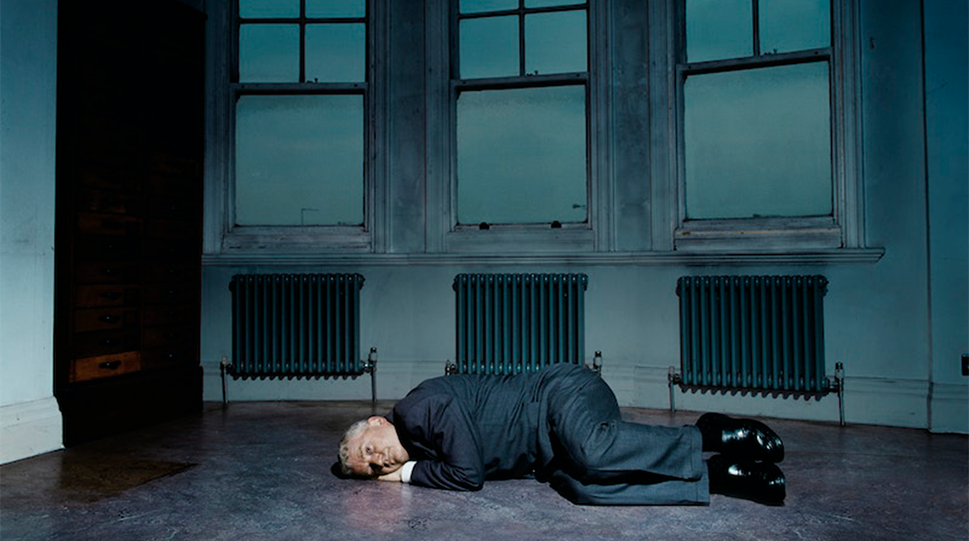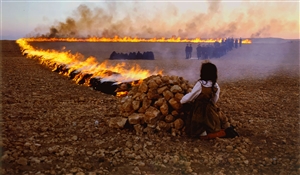Ordinary Citizen: A Critique of the Series "Lost Time" by Mitra Tabrizian
30 Aug 2022Original text in Farsi by Roozbeh Maleki
Translated to English by Omid Armat
Mitra Tabrizian, an England-based Iranian artist, moved to England alone in 1977 when she was young, a while before the Iranian Revolution. She first attended an international school and then studied photography at the Royal Polytechnique Institution in London. Most of her works are not directly related to Iranian culture and events. She thinks Iranian artists should not limit themselves to issues about their country. She believes they would lock themselves in their homeland borders by calling themselves "Iranian artists" while they are living out of Iran. Instead, they can observe global issues while noting their own country.
Tabrizian has been familiar with photography since her youth. The issue of social class discrimination, according to herself, attracted her attention when she lived in Tehran. She took photographs of this subject, and meanwhile, she got acquainted with critical theories. However, she soon realized that documentary photography would not necessarily lead to a specific result. Therefore, she took up staged photography to continue her career. Twenty series of photographs produced between 1987 and 2021, all centered on staged photography, are available on Tabrizian's website. Invited by the Tehran Museum of Contemporary Art, Tabrizian came to Iran and displayed her works during her speech at the 9th edition of Iran's Photography Biennale (2004). As a globally successful figure in this field, she profoundly increased the popularity of staged photography in Iran to a great level that it could even be assessed as a wave during the 2000s and early 2010s. This text scopes out her series "Lost Time," released in 2002.

Lost Time | 2002 | Source: www.mitratabrizian.com
Tabrizian has presented an enlightening explanation about this series:
After Japan's economic recession in the 90's when many smaller businesses went bankrupt, some businessmen would still put on their suits and leave the house in the morning, not telling their families what had happened to their business. Some never returned. They disappeared in the city. They blamed themselves for their 'failure'.
The series "Lost Time" depicts men and women in their 40s and 50s who are ready to go to work but appear somewhere else between 9 am to 6 pm. Like the Japanese businessmen who couldn't cope with their new living conditions, the characters in "Lost Time" feel they have nowhere to go, are deviated from their path, and don't know what to do! Some don't leave home, while others are lost in the city.
The project is actually a critique of organizational culture. We are moving toward a period in which young people are unreasonably bound more than ever, and the middle-aged are of no use anymore and are increasingly persuaded into early retirements. While in the past, the young had vigilance and the old had wisdom, now the young seem to have both!

Lost Time | 2002 | Source: www.mitratabrizian.com
So the series refers to the concept of Ageism; this is displayed with a feeling caused by inactivity before middle age, lack of demand, and eventually failure in a society where working and rivalry prevail over all other values. On another level, this work is an ironic interpretation of today's moral values. What is left for us to stick to when we are deprived of our organizational identity?
As Tabrizian's statement suggests, she has tried to produce her images with regard to her concerns that are mostly critical and universal, can be generalized to different people, and accord with the globalization concept of art. In "Lost Time," we see middle-aged individuals caught in the increasing speed of life and the change in living mechanisms of metropolises, encountering severe problems in every new crisis. Some can overcome these situations, while others seem to be dislodged from this world. It should be noted that the photographer herself was in her middle age period when producing this series of photographs. Although she didn't face such conditions, she met the probability of engaging in similar crises. This may be why she has written the last sentence of her text in the first person.
A documentary film about the closure of small businesses in Japan broadcasted on television, according to Tabrizian, was the starting point of this series of photographs. The film shows people who, despite becoming bankrupt, left home in the mornings and returned after working hours. They wandered around the city, so their families won't know their business was shut down. This attracted Tabrizian's attention because she believes there is a Western notion that says you must always be successful. The artist is criticizing such a notion by exposing its consequences. Therefore, she has placed each character lonely in a cold scene. Body positions and facial expressions have the most notable expressive qualities in these photographs. Therefore, this series has accomplished displaying the characters' senses of loneliness, confusion, and not a very pleasant outlook.

Mitra Tabrizian | Lost Time #8 | 2002 | c print | 122 × 152 cm
In one of the pictures, a middle-aged man is sitting on a bed, probably in a cheap motel. Being juxtaposed with other images of the series and based on the description provided by the artist, the image represents a time during the daylight hours. The man can take a rest in the room. Instead, he has closed the room's curtains, turned on the TV set on the wrong frequency, and is waiting in his formal suit for the working hours to finish. In another photo, a woman in a formal dress is passively waiting in a bathroom, or a man, looking pensive, is lying on the ground in an empty house. Almost all images include limited elements and have simple, solid compositions that let the viewer concentrate on the facial expression and body position of the depicted individuals that are so desperate that we cannot figure out what they are thinking about. They seem not to have a clear understanding of their situation and have become devoid of their selves (what they were some while ago). Tabrizian explains that she selected these positions and expressions to match closely with what the characters have in mind.

Mitra Tabrizian | Untitled | 2002
Homi K. Bhabha writes in an essay that Tabrizian's works always propound a particular issue: "who are people?". In order to investigate this issue, she displays individuals who seem to be strangers and no longer correspond with conventional designations of power institutions. In other words, people in these photographs are not apparently or legally "ordinary citizens." By focusing on these individuals, Tabrizian criticizes what produces ordinary citizens. She doesn't concentrate on the individuals who, for any reason, cannot fit into the position of a regular citizen. Instead, she addresses what caused these people not to be ordinary citizens anymore and experience loneliness and confusion, people who were considered normal citizens due to the socioeconomic roles they played some time ago in society. They are treated as if they are objects that were fashionable not long ago but are currently experiencing obsolescence and waiting to see whether or not there will be a place for them in the next economic boom.
There is a notable point in these pictures; although characters are depicted individually in each frame, it is impossible to identify them or understand what is in their minds, as Homi Bhabha explains (Herfeh: Honarmand). It seems that the viewer can only appreciate their situation negatively; they can only understand who these people are not. The characters have lost a period when they had social identities. Accordingly, the viewer can only know that these characters are not ordinary citizens; who they actually are is unknown to the people in crisis and to any other individual.

Jeff Wall | A Sudden Gust of Wind After Hokusai | 1993
The relative artificiality of the images is one of the interesting features of Tabrizian's works. She believes that such artificiality suggests the people's forms of lives in society, especially in huge corporations. In simple words, the settings of the images are as artificial as an individual's daily life in a metropolis. On the other hand, such an artificial quality is visible in nearly all staged works. This matters because Tabrizian refers in her works to various images in photography, cinema, and painting. For instance, her photograph of a man lying on the ground in an empty room clearly refers to Jeff Wall's "Insomnia" (1994). Also, Tabrizian's picture of a man standing in the middle of a place like a park while torn pieces of paper flowing out of his hand with the wind is reminiscent of "A Sudden Gust of Wind After Hokusai" (1993) and "Milk" (1984) by Jeff Wall.
Nevertheless, what distinguishes Tabrizian's work from other photographs representing people in similar conditions is the socioeconomic issues that she propounds. Most similar works don't go further than being a general statement about boredom and loneliness. In other words, like other works by Tabrizian, this series is also formed as a critique of the consumer society and today's living conditions. However, her work goes beyond a general review of the issue and refers to a specific happening in the real world. On the other hand, Tabrizian's photos are straightforward and refined, meaning that she uses precise exposures and avoids including unnecessary elements in the frame. She believes that such measures, which indicate an emphasis on the surface and appearance of the work, attract the viewer and give them more time to gain deeper interpretation. Most photographers who have produced works of staged photography during the last two decades in Iran have failed to include at least one of the two mentioned elements in their works: straightforward and refined appearance; and thorough social-cultural content.
Cover and slider image:
- www.mitratabrizian.com






